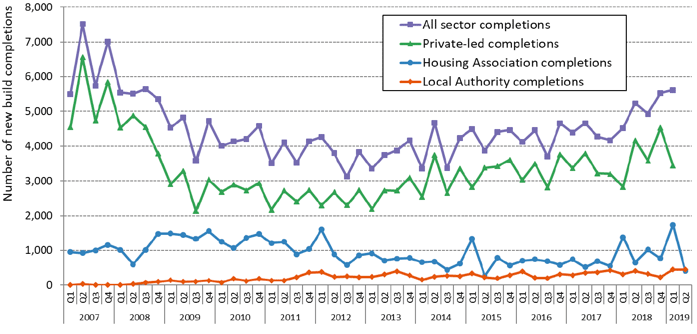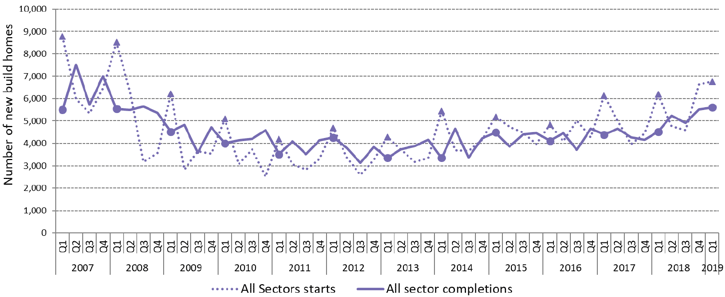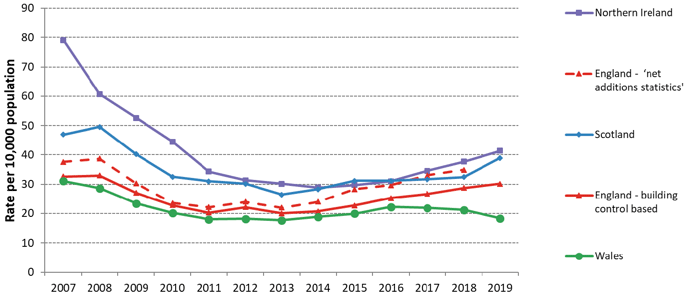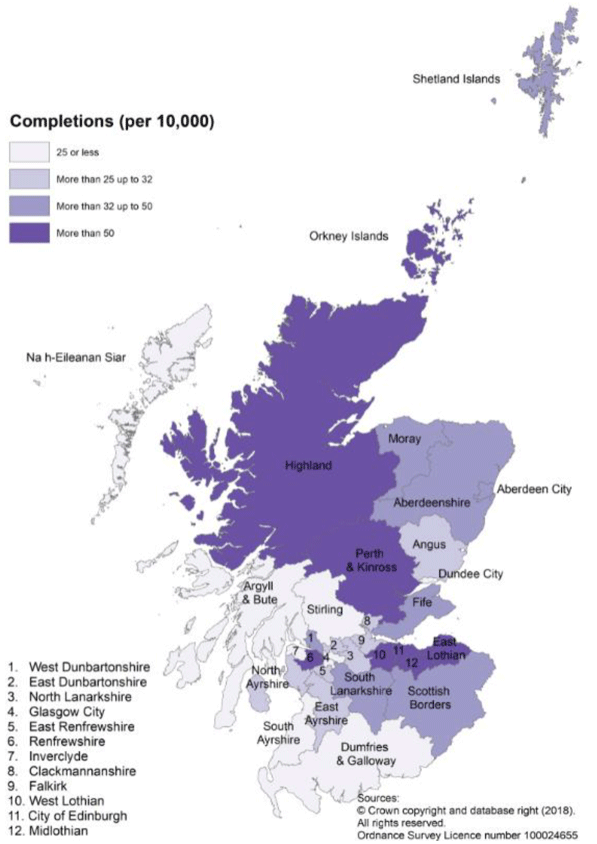Housing statistics quarterly update: September 2019
Trends in new build housing starts and completions by sector, and the Affordable Housing Supply Programme.
New Build Housing – All Sectors – up to end March 2019
The new-build section of this document provides figures on the number of homes started (when the foundations are begun) and completed (when a building inspector deems the property complete).
Figures are presented for homes built on privately led (referred to throughout as private sector), local authority led (referred to as local authority sector) and housing association led (referred to as housing association sector) sites. For the private sector the latest information available is for the quarter ending March 2019. Whilst more up-to-date information is available for local authority and housing association new builds, findings for these sectors are mainly presented up to March 2019 to simplify comparisons between sectors.
The figures have not been seasonally adjusted and so commentary tends to compare the latest quarter with the same quarter the previous year. To help with this, Quarter 2 figures (from April to June) have been highlighted in the charts to allow easy comparison over time. Some of the peaks in the number of starts in Quarter 1 each year are due to large numbers of housing association approvals being granted near the end of the financial year.
Trends since 2007 – all sectors
Chart 1 shows the annual number of all-sector new build homes completed since 2007 over years to end March, whilst Charts 2 and 3 (below) show quarterly trends in starts and completions across all sectors and by individual sector.
Chart 1 shows that annual all-sector new build starts and completions (years to end March) have both increased in each year since 2013, with increases in the latest year of 16% and 21% respectively, but are still below levels seen in 2007 and 2008.
Chart 2 presents new build completion trends on a quarterly basis and by sector, which shows the impact of the recession in the second half of the last decade, with private sector led completions falling throughout 2008 and 2009 due to the financial crisis. Chart 3 presents quarterly trends in all-sector starts and completions, which are generally showing an upwards trend since the end of 2017, but with some quarterly volatility evidence, particularly for starts.
Chart 2: Quarterly new build completions show some overall increases over the latest four quarters, although as with earlier time periods, figures for individual quarters can show some volatility over time

Chart 3: Quarterly new build starts and completions across all sectors show an generally upward trend since the end of 2017, but with some quarterly volatility evident, particularly for starts

Trends to end March 2019 – all sectors
There were 5,612 new build homes completed between January and March 2019; a 24% increase (1,092 homes) on the same quarter in 2018. This brings the total for the year to end March 2019 to 21,292, up 21% (3,669 homes) compared to the 17,623 completed in the previous year.
There were 6,759 new build homes started between January and March 2019, 9% more (566 homes) than the same quarter in 2018. This brings the total for the year to end March 2019 to 22,764 which is up 16% (3,160 homes) compared to the 19,604 homes started in the previous year.
Comparison with the rest of the UK from 2007 to 2019 – all sectors
Each of the countries of the UK produces their own statistics on quarterly new build housing starts and completions by tenure, and all use broadly consistent definitions. These new build statistics for each of the countries of the UK, as well as for Great Britain and the UK as a whole can be found here: https://www.gov.uk/government/statistical-data-sets/live-tables-on-house-building.
In addition to this, the Ministry of Housing, Communities and Local Government (MHCLG) also produces an additional annual set of statistics for England on new build homes, as a component part of the 'Housing supply; net additional dwellings, England' set of statistics.[1] These statistics are collected on a different basis to the quarterly UK country statistics as local authorities can use a range of data sources to collate these figures rather than solely using building control information. Figures on this for 2016/17 were published on 16 November 2017, and this publication advised that the 'net additional dwellings' should be considered the primary and most comprehensive measure of housing supply in England.
MHCLG have advised that the quarterly new build statistical collection for England, whilst being a useful leading indicator of activity throughout the year, is not currently capturing all new build activity, largely due to difficulties in collecting accurate starts and completions data from independent building inspectors or where building control has been sourced out to strategic partnerships or the private sector. These data issues do not exist in the Scotland quarterly housing statistics, given that all of the 32 local authorities in Scotland directly manage building control and the associated provision of data to the Scottish Government on starts and completions.
As a result of this advice, the new build component figures of the 'net additional dwellings' statistics for England are included in the UK comparisons as an additional set of figures to consider when comparing between countries. However note that the latest 'net additional dwellings' figures available are for 2017/18 so there is no data to compare for 2018/19.
Chart 4 shows that the rate of house building completions in Scotland has been above that of England (building control based figures) and Wales throughout the 2007 to 2019 period (years to end March). In the latest year, the rate in Scotland (39 per 10,000 population) has been above the comparable quarterly statistics for England (30 per 10,000 population), and the rate of 'net additional dwellings' new builds in England for the previous year 2017/18 (35 per 10,000 population), although a figure for England for the latest year 2018/19 is not yet available. The rate of house building completions in Scotland has been below that of Northern Ireland between 2007 and 2019, except for in 2015 and 2016.
Chart 4: New house building as a rate per 10,000 population (years to end March) - Scotland had a rate of 39 in the latest year, below Northern Ireland (41), but higher than England building control figures (30) and Wales (18)

Sub-national figures for the year to end March 2019 – all sectors
The information on new build housing in Scotland is collected and published at local authority level. Map A, below, shows new house building in the year to end March 2019, as a rate per 10,000 population based on the latest mid-2018 population estimates.
In the year to end March 2019 the highest new build rates were observed in Midlothian, East Lothian, Perth & Kinross, Highland and Orkney Islands. The lowest rates were observed in Dumfries & Galloway, Dundee City, Stirling, Na h-Eilean Siar and Argyll & Bute.

Contact
Email: felix.palin@gov.scot
There is a problem
Thanks for your feedback